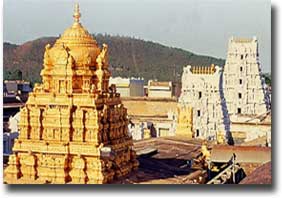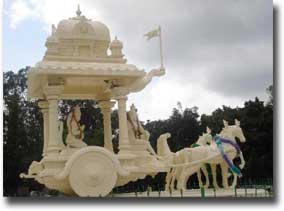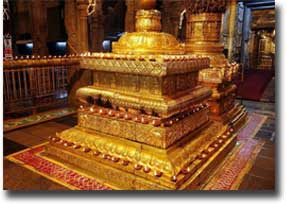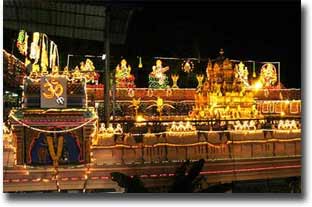Location
Tirupati serves as a pilgrimage center of great significance and is visited by hundreds of thousands of pilgrims throughout the year.Venkateswara, or Srinivasa or Balaji as the presiding deity Vishnu is known, is enshrined in this temple, located on a range of the Eastern Ghats, called the Seven Hills.It is an ancient temple and its glory has been sung by the saints of the yester-years.
This temple is known to be the richest temple in India as it has a vibrant cultural and philanthropic institution with a grand history spanning several centuries. It attracts pilgrims from all over the country and it is not unusual for pilgrims to stand in line for hours together to obtain a glimpse of the presiding deity for a few fleeting seconds.

Significance of the temple
Brahmotsavam Celebrations: Brahmotsavam is the biggest fair of Lord Venkateswara. Its beginning is marked by the Dhwajarohana which involves the hoisting of the Garudadhwaja (flag with the emblem of a black garuda), near the Srivari Alaya Dhwajasthambham.
During Brahomatsavam, a spectacular procession of Lord Venkateswara on the Pedda Seshavahana is taken around the four streets of the main temple from 2200 hrs till midnight. The meaning of Sesha is 'to serve'. Adi Sesha is a thousand-headed serpent, on whom Lord Sri Maha Vishnu rests in his abode, Vaikuntam.
Procedures followed during the celebrations
Aalaya Suddhi:This is the initial step followed. The temple of Lord Sri Venkateswara is cleaned before beginning the Brahmotsavam, according to the guidelines given in the religious texts. The temple premises and its surroundings are decorated with flowers and mango leaves. This process is called Aalaya Suddhi and Alankaram (decoration).
Mritsangrahanam: It is the process of collecting earth and is carried out on the day prior to the first day of Brahmotsavam. The temple priests and officials pray to deities like Vishvaksena, Anantha, Sudarshana and Garuda. They also pray to Mother Earth and collect a small quantity of earth, with which the Ankurarpanam ritual is conducted. In Ankurarpanam, the earth is spread in a room and nine kinds of cereals are sown in it.
Dwajarohanam and Devatavanam : The Dwajarohanam -the hoisting the flag or the garudadhwaja signals the beginning of the Brahmotsavam. It is carried out at the Dwajasthambham, near the Nadimi Padi Kavili inside the temple complex. The temple officials hoist the flag with a picture of Garuda on it to the chanting of Vedic mantras by the temple priests. It is believed that Garuda goes to the Devalokam to invite Gods like Brahma, Indra, Yama, Agni, Kubera and Vayudeva and sages like Vasistha and Vishwamitra.

Srivari Koluvu: After being taken around in a procession during Brahmotsavam, the Lord holds court in the main temple. The Naivedyam is offered by the temple priests during this time.
Snapanam: The Snapanam which is also called as the Utsavananthara Snapanam, is the process of bathing the Lord with herbal water after the procession. It is believed that the strain which the Lord had undergone during the procession will be relieved through the herbal water bathing.
Choornabhishekam: The Choornabhishekam involves bathing the lord and his consorts after immersing them with sandalwood powder. Usually, this is performed on the morning of the ninth day of the Brahmotsavam. Again the Lord is taken in a procession around the streets of Tirumala. The temple priests distribute the sandalwood powder used for the Lord to devotees. It is believed that the sandalwood powder has the power of clearing obstacles from one's path.
Chakrasnanam: The Chakrasnanam ritual is similar to the bathing ritual and this is performed after the performance of a yagna. On the morning of the last day of Brahmotsavam, the Lord, his consorts and Sri Sudarshanachakram are bathed in the Swami Pushkarini. The devotees can also take bathe in the Swami Pushkarini, along with Sri Sudarshanachakram. As it is considered to be a very sacred ritual, severeal devotees participate in this ritual, irrespective of religion, caste or creed.
Architecture of the temple
The ancient Tirupati temple follows the Dravidian style of architecture. The gopuram of this temple is its highlight. The 'Vimana' or Cupola, named the "the Ananda Nilayam" is placed over the sanctum sanctorum. It is completely veiled with gold plate. There are three 'Prakarams' or enclosures in the temple, among them the outermost enclosure boasts of the 'Dhvajastambha' or the banner post. Apart form these, other highlights of the temple are the statues of Vijayanagara king, Krishnadevaraya and his spouse. There is also an idol of Todarmal, the minister of Akbar.
 |
Nearby tourist places to Tirupathi Temple
Tirupathi Visakhapattinam Warangal |
The image of the temple deity represents both Lord Vishnu and Lord Shiva. Lord Vishnu is considered as the preserver whereas the Lord Shiva is considered as the destroyer in Hindu religion. |
Time to visit
Till date, the lavish temple follows complex rituals and sermons of worship that were prescribed by Ramanuja Acharya in the 12th century. Every day, the program begins with 'Suprabhatam', which encompasses awakening of the Lord at 3'O clock in the morning. 'Ekanta Seva' is the last program, in which, the Lord is made to sleep at 1'O clock in the night.
As per the day and period, different 'sevas' (services) and 'utsavams' (festivals) are held in the shrine of the Lord. 'Hundi' is a donation box and this is the main source of temple's income. Devotees offer donations as per their desire in these boxes that are kept at intervals in the temple. For the ease of the pilgrims, different 'darshans' including 'Sarvadarshan', 'Special Darshan' and 'Sudarshanam' are prearranged.
TTD has organised efficient systems to ensure the smooth movement of pilgrims as lakhs of pilgrims have been visiting the Sri Venkateswara Temple every day.

Special Darshan: The Special Darshan has shorter queue and waiting time. The entrance for Special Darshan is through the PPC (Queue Complex). The queue merges with the Sarvadarsanam queue at Bangaruvakili. There are two categories of special darshan with the same timings of the Sarvadarsanam.
Sudarsanam Token System: The Sudarsanam token system was introduced to minimise the waiting time for Sarvadarsanam, Special Darshan and other paid Darshans and Sevas. It has some features which are as follows:
There are free tokens available at the First Choultry (opposite the Tirupathi Railway Station), Second Choultry (behind the Railway Station), Alipiri Bus Stand, Tirupati, Vaikuntam Queue Complex, Pilgrim Amenities Centre (Near CRO) and near the Rambagicha Guest House in Tirumala.
Other places to visit
Bhadra Kali Temple is situated on a hilltop between Hanamkonda and Warangal, it is noted for its stone image of the Goddess Kali.
Jain Temple which is 2,000-year-old Jain temple of Mahaveer is a famous place of worship for Jains in the country. The temple is embellished with beautiful images of Thirthankaras. The 5ft high image of Mahavira is entirely carved of Jade. Kolanupaka is 80-km from Hyderabad, and is situated between Hyderabad and Warangal. This was the second capital town of Kalyani Chalukyas during the 11th century AD. During this period the village was a religious centre of Jains, and ranks among other great Jain centers in the south.
Sri Veeranarayana Temple is raised in the Chalukyan style around 1104 AD.
Pakhal Lake is a man-made lake built in 1213 AD by the Kakatiya king, Ganapathidev, by harnessing a small tributary of the Krishna River. It is located 50-km from Warangal and spreads over an area of 30-sq-km.
Temple Architecture
The ancient Tirupati temple follows the Dravidian style of architecture. The gopuram of this temple is its highlight. The 'Vimana' or Cupola, named the "the Ananda Nilayam" is placed over the sanctum sanctorum. It is completely veiled with gold plate.
There are three 'Prakarams' or enclosures in the temple, among them the outermost enclosure boasts of the 'Dhvajastambha' or the banner post. Apart form these, other highlights of the temple are the statues of Vijayanagara king, Krishnadevaraya and his spouse. There is also an idol of Todarmal, the minister of Akbar.
The image of the temple deity represents both Lord Vishnu and Lord Shiva. Lord Vishnu is considered as the preserver whereas the Lord Shiva is considered as the destroyer in Hindu religion
Accomodation near the temple
Sri Govindaraja Dharmasala and Sri Kodanda Rama Dharmasala situated on the northern side of the Tirupati East Railway station provide unfurnished accommodation with cooking facilities to pilgrims.Pilgrims on arrival may contact the Superintendent, Central Reception Office at the Dharmasala.
The Tirumala Tirupati Devasthanams have made several innovations in the Daily Seva Timings in the Tirumala Temple to reduce the waiting time of the pilgrims in the queue halls. At the same time the following facilities are available to the pilgrims so that their waiting in the queue halls is not tedious. Hygienic, airy, large queue halls provided with overhead fans. Catering inside the halls by Coffee Board. Sale of food packets at reasonable prices. Sale of pure milk by the Andhra Pradesh Dairy Development Corporation and Medical first aid.
How to reach the Temple
- Through Airways: The nearest airport is at Renigunta(15 kms). Tirupati is connected by air with Hyderabad, Chennai and Bangalore. From the airport one can hire a taxi or an auto rickshaw or take a bus to reach the temple.
- Through Railways: Through railways, the town of Tirupati is well connected by roads and proper transport services to the nearest railway station situated at Tirupati. This place is connected by rail with Hubli, Hyderabad, Chennai, Kolhapur , Mumbai, Puri, Tiruchirapalli, Varanasi and Vijayawada.
- Through Roadways: Through Roadways to reach Tirupati temple, one should first reach Tirupati. It is linked with important cities like Hyderabad (617), Bangalore(248), Chennai(151 km), Vijayawada(380 km) and Lepakshi (379 km) through good roadways.



